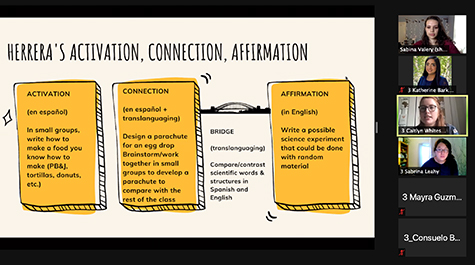William & Mary students collaborate with and learn from educators and advocates to promote dual language bilingual education
The Virginia Dual Language Education Network partnered with the Virginia Department of Education (VDOE) Office of World Language to host the second annual Dual Language Immersion Day in February as a part of the movement to create more spaces for dual language instruction throughout Virginia.
The Virginia Dual Language Educator Network is a big proponent of increasing awareness about dual language programs and has worked together with the VDOE and school districts throughout the state to bring close to 225 educators, researchers, and advocates together to learn about teaching practices in multilingual classrooms.
The conference introduced W&M School of Education students to a community of dual language educators in Virginia where students learned from experienced leaders in the field and added their voices to the conversation about how to promote dual language instruction in PK-12 classrooms.
Paola Mendizabal, a Ph.D. student in Curriculum & Learning Design, presented a project titled “Planning a Biliteracy Unit with your Partner.” In her teaching experiences, she approaches dual language learning by partnering with other teachers who speak different languages so that students can learn in both languages. The two-way model includes two teachers, one who speaks English and another who speaks Spanish. The teachers each have their own classes that are taught in each language and students learn from both teachers.
“It's been my experience from networking with other dual language educators that there's a lack of a curriculum that aligns to dual language goals such as biliteracy, biculturalism, bilingualism, and high academic achievements. Many times dual language programs are a strand within a school, and teachers are expected to teach a monolingual curriculum, so adjustments need to be made,” Mendizabal says.
Mendizabal stumbled upon dual language teaching when a Spanish dual language position opened in her school district. She thought it would be a great opportunity to teach in her native language and the more she learned about dual language, the more passionate she became about it.
Dual Language Bilingual Education (DLBE) programs enhance the learning experience for English speakers while helping students who are in the process of learning English maintain and affirm their home language and culture. Decades of research supports these programs and finds that emergent bilinguals in DLBE programs score significantly higher on state tests and achieve higher proficiency in English than English learners in ESL-only programs. These findings are also supported by other studies that have looked at the effects of language programs on students with different racial backgrounds and learning abilities.
“Education is referred to as 'the great equalizer,' and dual language seems to offer a feasible solution to education equity problems,” Mendizabal says.
Sabina Valery and Caitlyn Whitesell, students in the ESL/Bilingual Education M.A.Ed. program, worked with Margaret Wells, an undergraduate majoring in sociology and minoring in Educational Studies, to present a project titled, “The Scientific Method: Active Science Learning Online,” about creating and implementing a science unit for a sixth grade dual language class taught in Spanish. Their curriculum included opportunities for students to be active participants and engage in both Spanish and English speaking.
Valery was drawn to dual language education because she recognizes that developing biliteracy from an early age is becoming more essential. Dual language programs allow students who speak other languages to learn English while honing their native language skills as well.
“As I see it, when implemented effectively, a dual language program offers only benefits to all groups of students, and has the capacity to truly honor the diverse heritages of our culturally and linguistically diverse students,” she says.
The field of dual language education brings linguistic equity to instruction, where language learning is integrated throughout the entire curriculum and language is taught using math, social studies, language arts and science as context, says Dr. Katherine Barko-Alva, assistant professor and director of ESL/Bilingual Education. “It also emphasizes advocacy efforts to support multilingual students and their families.”
“As a dual language advocate, it is important to collaborate with other DLBE educators, to share ideas, to learn from one another,” Mendizabal adds. “Together we can continue la lucha, the fight for equity for our students.”
